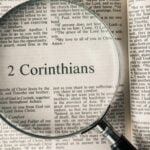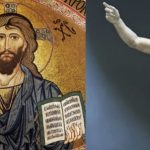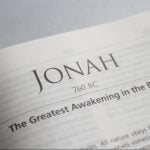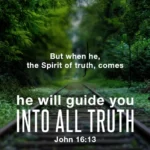
Bible Study Helps: John
Here are some helps as you study John’s Gospel:
The Gospel of John is a favourite of many Christians. Edward Klink puts it this way: “This particular Gospel and book of the Christian Bible has been one of the most frequented and theologically significant in the entire canon, maybe in all the literature of the world.” By way of introduction, a few other words of praise for the book can be presented here. Richard Phillips said this:
In studying the Gospel of John, believers soon realize that it is far more than a human composition: only God the Spirit could have written in such profound simplicity, such accessible depth, and such arresting beauty. Countless readers have had their objections to Christianity abashed in light of this inspired testimony to Christ himself, exclaiming with the temple guards, “No one ever spoke like this man” (7:46).
Or as Leon Morris wrote: “I like the comparison of John’s Gospel to a pool in which a child may wade and an elephant can swim. It is both simple and profound. It is for the veriest beginner in the faith and for the mature Christian. Its appeal is immediate and neverfailing.”
John’s insights into the life of Christ are unique among the gospels. The Gospel differs from the first three gospels – what we call the synoptic gospels – in various respects. The first three gospels offer us a synopsis of the life and ministry of Jesus. Of course John also offers us some biological details of his life, but the gospel is the most theological of the four gospels.
Indeed, John is unique in clearly spelling out its purposes. As we read in John 20:30-31: “Now Jesus did many other signs in the presence of the disciples, which are not written in this book; but these are written so that you may believe that Jesus is the Christ, the Son of God, and that by believing you may have life in his name.”
In an earlier piece on the synoptic gospels I discussed in more detail the various differences found between them and John: https://billmuehlenberg.com/2018/09/25/bible-study-helps-the-synoptic-gospels/
Among the many key emphases found in the fourth gospel is this: it is the one most devoted to the deity of Christ and the one especially stressing that he is the long-awaited Messiah. This is done both by what Jesus said and by what he did. Consider for example the various “I am” sayings of Jesus.
Harking back to the self-identification of God to Moses as the great “I am” at the burning bush (Exodus 3:14), Jesus repeatedly established his divine identity by these sayings. The deity of Christ is of course affirmed throughout this gospel, beginning with the claim of him being God (John 1:1). But these sayings reinforce this theme and make clear his Messianic self-consciousness. They are:
I Am He – John 4:1-26
I Am the Bread of Life John – 6:25-51
I Am the Light – John 8:12-30
I Am (before Abraham was,) – John 8:31-59
I Am the Door of the Sheep – John 10:1-21
I Am the Good Shepherd – John 10:1-21
I Am the Resurrection and the Life – John 11:1-27
I Am the Way, the Truth and the Life – John 14:1-14
I Am the True Vine – John 15:1-8
And then we have the seven signs, or miraculous deeds. They attest to the divine nature and eternal godhead of Christ. Indeed, one of the reasons John gives for writing his gospel is that people might come to faith in Christ. John highlights the many miracles (or signs) performed by Jesus as a means to that end:
“Jesus did many other miraculous signs in the presence of his disciples, which are not recorded in this book. But these are written that you may believe that Jesus is the Christ, the Son of God, and that by believing you may have life in his name” (John 20:30-31).
Signs therefore play a very important role in John’s gospel. As Beasley-Murray says in his commentary, “The major part of this Gospel is taken up with the narration of the signs performed by him and expositions of their meaning.” The sign miracles are these:
-Turning the water into wine – John 2:1-11
-Healing of the nobleman’s son – John 4:46-54
-Healing the paralytic at Bethesda – John 5:1-17
-Feeding the 5000 – John 6:1-14
-Walking on water in John 6:16-21
-Healing a blind man – John 9:1-11
-The raising of Lazarus – John 11:1-44
Because John gives us such a rich theological presentation of the life and work of Christ, Martin Luther could say this about it: “This is the unique, tender, genuine chief Gospel. . . . Should a tyrant succeed in destroying the Holy Scriptures and only a single copy of the Epistle to the Romans and the Gospel according to John escape him, Christianity would be saved.”
But differences in content and style between John and the other gospels must not be pushed too far. There is still much in common. Bruce Milne for example offers us this listing of similarities:
All four feature the witness of John the Baptist as the historical prelude to Jesus’ ministry, the call and instruction of the disciples, the miraculous feeding of the 5,000, Jesus’ voyage with his disciples on the sea of Galilee, Peter’s confession of faith, the triumphal entry into Jerusalem, Jesus’ remarkable claims and his acts of power, the developing opposition and hostility of the Jewish religious leaders, the cleansing of the temple, Jesus’ final meal with his disciples, his arrest in Gethsemane, his trial, condemnation and crucifixion, his resurrection from the dead on the third day, his resurrection appearances and his commissioning of his disciples. In addition there are numerous specific sayings which are common or appear in parallel form in all four gospels. This is a not inconsiderable list.
A very simple outline of the book, as put forward by Raymond Brown, is as follows:
1:1-18 Prologue
1:19—12:50 Part One: The Book of Signs
13:1—20:31 Part Two: The Book of Glory
21:1-25 Epilogue


Commentaries – devotional, expository
Boice, James Montgomery, The Gospel of John, 5 vols. (Baker, 1985, 1999)
Hughes, R. Kent, John (PTW, 1999)
Phillips, Richard, John 1-10 (REC, 2014)
Phillips, Richard, John 11-21 (REC, 2014)
Pink. A. W., Exposition of the Gospel of John (Zondervan, 1945, 1975)
Sproul, R. C., John (Reformation Trust, 2009)
Commentaries – scholarly, academic
Beasley-Murray, George, John (WBC, 1987)
Brown, Raymond, John, 2 vols. (AB, 1966, 1970)
Burge, Gary, John (NIVAC, 2000)
Carson, D. A., The Gospel According to John (PNTC, 1991)
Keener, Craig, The Gospel of John, 2 vols. (Hendrickson, 2003)
Klink, Edward, John (ZECNT, 2016)
Kostenberger, Andreas, John (BECNT, 2004)
Kruse, Colin, John (TNTC, 2004)
Michaels, J. Ramsey, The Gospel of John (NICNT, 2010)
Michaels, J. Ramsey, John (NIBC, 1989)
Milne, Bruce, The Message of John (BST, 1993)
Morris, Leon, Gospel According to John (NICNT, 1971)
Ridderbos, Herman, The Gospel of John: A Theological Commentary (1997)
Tasker, R.V.G., The Gospel According to John (TNTC, 1960)
Tenney, Merrill, John (EBC, 1981)
Thompson, Marianne Meye, John: A Commentary (NTL, 2015)
Wright, N. T., John for Everyone, 2 vols. (WJK, 2002, 2004)
Other studies on John
Bauckham, Richard, Gospel of Glory: Major Themes in Johannine Theology. Baker, 2015.
Bauckham, Richard, The Testimony of the Beloved Disciple: Narrative, History, and Theology in the Gospel of John. Baker, 2007.
Blomberg, Craig, The Historical Reliability of John’s Gospel. Apollos, 2001.
Edwards, Ruth, Discovering John: Content, Interpretation, Reception. Eerdmans, 2015.
Kostenberger, Andreas, Encountering John: The Gospel in Historical, Literary, and Theological Perspective, 2nd ed. Baker, 1999, 2013.
Kostenberger, Andreas, A Theology of John’s Gospel and Letters. Zondervan, 2009.
Smalley, Stephen, John: Evangelist & Interpreter. IVP, 1978, 1998.
Thompson, Marianne Meye, The God of the Gospel of John. Eerdmans, 2001.
A few forthcoming commentaries on John to be aware of include Richard Bauckham (NIGTC), and Nicholas Perrin (SoGBC). As to my main picks, let me offer a few recommendations: Carson, Kostenberger, and Ridderbos might top my list.
Happy reading and happy study.
(For Australian readers, many of these titles can be found at Koorong: www.koorong.com/ )
[1333 words]




















Looks like I’m the first to comment! Thanks for this article, Bill. You don’t seem to get as many comments on this kind of article; perhaps they’re not as “entertaining” as articles on current affairs.
One older commentary to watch out for, with much on John’s Gospel, is Liddon, H.P., The Divinity of our Lord and Saviour Jesus Christ (Longmans, 1894).
It’s prescient of you to write about John 8:12 at this time, where Jesus said,
Presient, because the organisers of Tasmania’s taxpayer-funded midwinter festival clearly had this verse in mind when choosing its name, to mock Jesus and his virgin birth.
(P.S. Sorry if this comment ends up as a jumbled mess; I leave a blank line where I want a new paragraph, but they’re chonked out somehow when I click “Post comment”)
Thanks Cathie. Yes these sorts of articles do not seem to get as many responses. But your comment came through fine thanks.